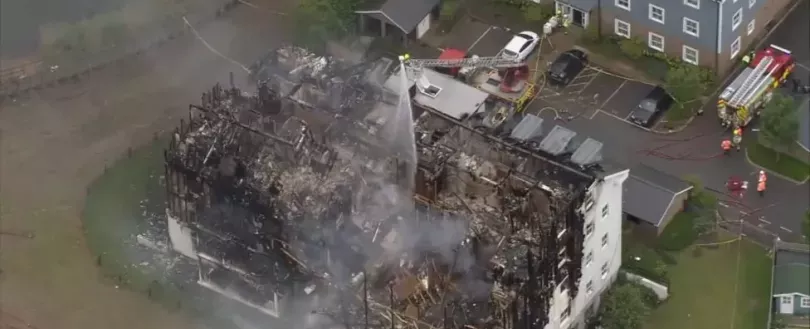
Living in the Shadow of Fire: Rebuilding Richmond House
Like it? Share it!
05 August 2025
"If I'd found somewhere else I would have gladly moved on," says Agnese De Masi, speaking from her stylishly furnished flat on the second floor of Richmond House.
She is one of just three residents who have returned to newly rebuilt homes on an estate of American-style houses in Worcester Park, south-west London.
Back in September 2019, a fire tore through the original block of flats within minutes. It took 125 firefighters five hours to bring the blaze under control – the building was completely destroyed.
Though the structure has been rebuilt, reminders of that night remain. Since March, the fire alarm has triggered repeatedly during the night, resulting in two full evacuations of the newly occupied flats.
"We live in fear," she says.
Ms De Masi, an interior designer, is still completing the decoration of her home as she works to piece her life back together. She was among 23 households who lost everything in the fire nearly six years ago.
Despite reservations, she moved back into Richmond House due to a lack of suitable alternatives nearby.
"I don't want to be away from my network of friends, which has been my safety net in the past few years," she explains.
Since the incident, she has experienced anxiety and symptoms of Post-Traumatic Stress Disorder (PTSD), making her especially sensitive to the recent alarm activations.
The system has triggered five times since March, with the London Fire Brigade (LFB) attending three of those callouts. Residents have been evacuated twice during the night.
"I had heart palpitations the whole day because obviously the alarm went off during the night, which is exactly what happened the night of the fire," she says.
"You go to bed and you don't know if you're going to be woken up by another alarm. It's not a pleasant situation to be in."
Concerns over communication
Metropolitan Thames Valley (MTVH), the housing association responsible for Richmond House, owns the freehold and manages the property. According to Ms De Masi, early concerns about the alarm system were not taken seriously.
She believes there was a lack of detail regarding work on the fire alarm system, with long periods of silence from the housing association reflecting a "complete lack of empathy".
Since then, MTVH has responded to several of her concerns and stated that specialists are now investigating the cause of the false activations.
A spokesperson for MTVH said: "We rebuilt Richmond House to the highest fire safety standards, and fully involved residents in the process."
Following the fire, the association "offered to buy back flats from any resident who wished to move on", and to help residents ease back into the building, it "offered residents a two-month grace period to move back in gradually".
"We know how distressing fire alarm activations are for all residents and we particularly understand the anxiety this may cause for those original residents returning to Richmond House. Their safety, and feeling of safety, is hugely important to us and has been our focus both during the rebuild and return to their homes," they added.
Serious fire safety failings uncovered
The original residents had only lived in Richmond House for nine years when the fire occurred. At the time, a stay-put strategy was in place, a measure which assumes fire will be contained long enough for a safe evacuation.
But the blaze spread rapidly through the timber frame. It was only through the quick thinking and mutual support of residents that there were no fatalities or serious injuries.
An investigation by the LFB and independent fire experts uncovered significant safety issues. These included missing cavity barriers and inadequate fire-stopping, which contributed to the fire’s rapid spread.
Ms De Masi was part of a group of residents who launched a £3 million damages claim against the building’s developer, St James, a Berkeley Group subsidiary, and the freeholder MTVH. The case was settled out of court for an undisclosed sum.
A long road to recovery
Christian Hansen, a partner at Bindmans representing the residents, said: "Since the Grenfell Tower tragedy, it's come to light that there are thousands of buildings across the country, which have been constructed with inadequate fire safety measures."
He drew parallels between the Worcester Park fire and another at the Spectrum building in Dagenham, which was destroyed in similar circumstances in August last year.
Mr Hansen added that most Richmond House residents "suffered traumatic psychological injuries on the night of the fire".
"Having to go through a years-long battle with the constructors and the freeholders in their claim for compensation, was in many cases re-traumatising and actually exacerbated the symptoms they were suffering," he said.
For Ms De Masi, the toll of litigation, rebuilding, and ongoing maintenance issues has been immense.
"It is a second job. It's a very frustrating second job, for which you don't get paid, you don't get holiday," she said.
"And it actually ages you because you're constantly trying to get justice and to balance things out. It's very difficult."
View the source.
Our eNews provides regular insight into industry trends, news headlines, and product and service information. For more articles like this Subscribe to our enews.
Related news
Related resources
-
Passenger Service Vehicle - Guidance Note
05 September 2023
